White Noise is Noah Baumbach‘s follow-up to his Oscar-nominated 2019 film Marriage Story. Reuniting with Adam Driver, Baumbach set out to adapt Don DeLillo‘s “unfilmable” 1985 novel of the same name — marking the first time he has directed an adaptation rather than an original piece of material. The film follows the Gladney family as they navigate an “Airborne Toxic Event” that feels just as relevant in 2022 as it likely did in 1985.
English Cinematographer Lol Crawley‘s career has run the gamut from TV (Black Mirror, The OA, the original Utopia) to film (Four Lions, Hyde Park on Hudson, Vox Lux), and his visual panache can be seen in the Netflix release The Devil All the Time, which featured a dark and grimy aesthetic that carried over to Crawley’s latest film for the streamer, White Noise. That darkness kicks in during the film’s third act, though the film does end on a light note, as Baumbach stages an elaborate dance sequence set to LCD Soundsystem inside of a colorful grocery store, which Crawley frames in a way that perfectly captures everything viewers need to see between the aisles.
Below the Line recently spoke with Crawley over Zoom about teaming with Baumbach on White Noise, the Michael Mann-like noir aesthetic of the film’s third act, and shooting inside that meticulously-designed grocery store.
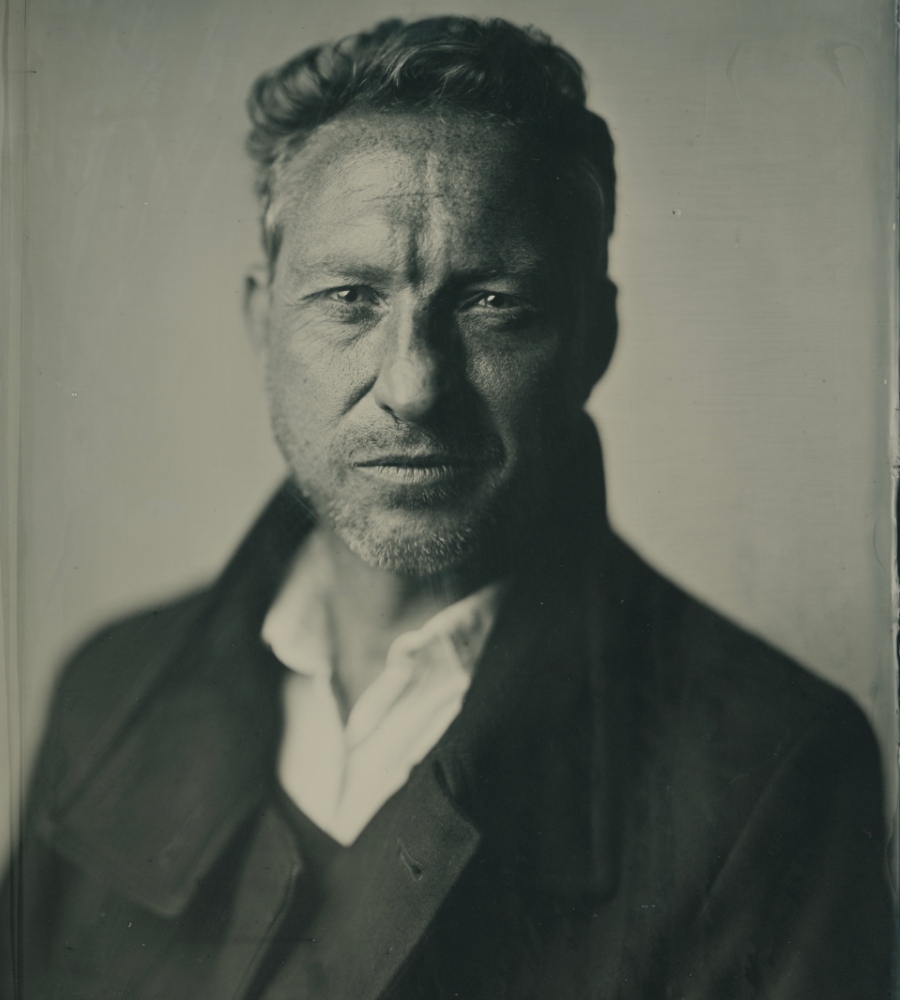
Below the Line: How did you first connect with Noah Baumbach and come aboard White Noise?
Lol Crawley: Well, obviously I’d been a fan of Noah [Baumbach]’s work. I worked with David Heyman on a film, The Secret Garden, that he produced. So I knew the Producer, David Heyman, [and] I also knew the Editor, Matt Hannam, and the two of them were instrumental in introducing me to Noah [Baumbach]. I know he’d seen a couple of the movies that I’d shot before, [like] Vox Lux, because Raffey Cassidy, who’s in White Noise, is also in there, and Matt edited [that film] as well. So I guess there was some connection there, [and] Matt and David were already on board White Noise.
BTL: Before I get more into White Noise, I know you’ve shot for all sorts of mediums, from music videos to film and television. What was the first type of project that you did? How’d you get your start?
Crawley: Well, I was in the UK. I’m now in L.A. and have been since 2019, but I studied and grew up in the UK, and then after film school, I worked with a British director [named] Duane Hopkins, and then I did short films with them, and then the short films led to a feature. My first feature, which was actually [filmed] in Mississippi, [was] called Ballast, which was at Sundance in 2008. So yeah, that was actually how that worked, and then I came to music videos and commercials after that.
BTL: Had you read the novel White Noise prior to the start of filming?
Crawley: I did. I read it before filming, but it wasn’t a text that I’d read in school. I think in the U.S. it’s a sort of school text or a college text. I think [it’s] maybe [due to] it being a U.S. novel, so it’s a more common text to study. So I wasn’t familiar with it, but I did read it before we commenced shooting.
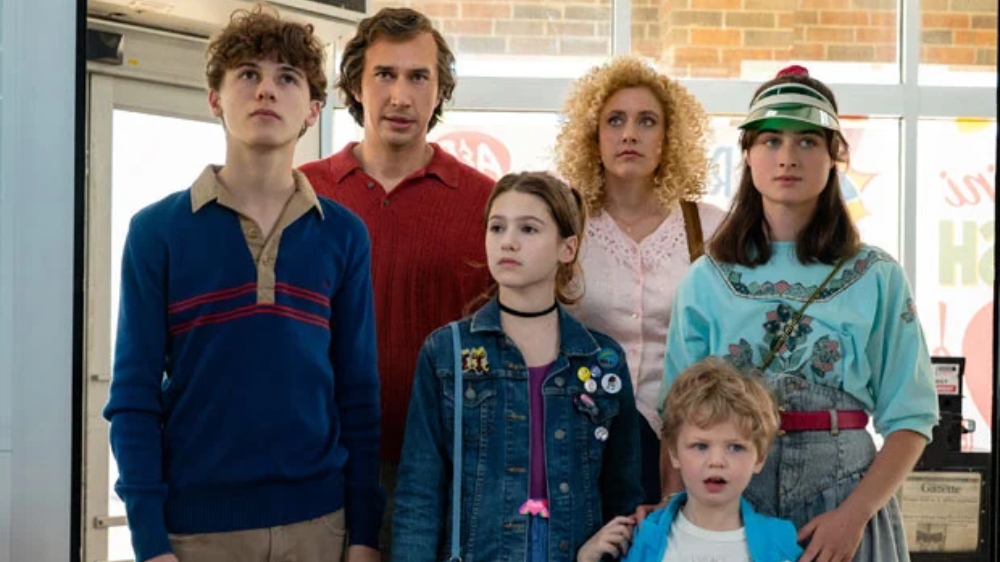
BTL: So after you read the book, did you have a better idea of how to shoot the movie and how you wanted it to look?
Crawley: I think that Noah and I shared the idea that it could reference the ’70s and ’80s movies in the sense of originating on film [and] shooting on anamorphic lenses. I think that felt correct. You know, I felt that it should have that aesthetic.
Obviously, one has initial responses and ideas, but I like to not be too dogmatic with my thoughts. I like to have an initial discussion with the director and understand where they’re coming from and see how I can build on those ideas as well, you know?
I think cinematographers have different approaches, but I like to keep quite an open mind early on and try and be responsive to different directions. [On] a number of projects I’ve worked on, I’ve [been] lucky in that the discussions about film or the desire to shoot on film have already been established, really, before I come on board. So this was something that was established with Netflix and Noah, the same with Antonio Campos [on] a film called The Devil All the Time — that was on 35mm, so I’ve been very lucky. I love shooting on 35mm and I’ve been lucky that I haven’t had to really battle for it; they’ve been decisions that were made before I came on, and this was the case with White Noise.
BTL: I’m actually really glad that you mentioned The Devil All the Time because that’s my favorite film from your filmography. So that one was shot on film as well then?
Crawley: It was, yeah, also on 35mm, but not anamorphic. White Noise was anamorphic and The Devil All the Time was spherical.
BTL: For newbies to the world of cinematography, can you briefly break down the difference between those two?
Crawley: Okay, well, I guess the closest comparison [for] spherical lens cinematography would be a standard spherical lens. You could shoot with a standard vertical lens just as you would on a still camera, so that’s a comparison. But then within that, you could also then crop your image to a different format. For example, The Devil All the Time still had a wide screen 2.35:1 aspect ratio because we just framed for that and cropped the image that way. With anamorphic cinematography, it’s a very different thing — it’s a technology that was developed. I mean, you could talk for a long time about this, but initially, it was actually, interestingly, developed I think by a French guy in the early part of the 20th century in order to be able to get a wider field of view whilst driving tanks in the military. And then that technology was used within cinema.
Essentially, what it does is it acts like two lenses in one. So if you have a 50mm amorphic lens, the vertical height is equivalent to the 50mm that you would know in a spherical lens, but it has the width of something like a 25mm [lens]. And the way that it does that is, basically, the lens itself is optically squeezed so that it’s pulling in light or information, pulling it in left and right, and squeezing it up. So if you actually look to the negative for anamorphic film, everything would be tall and thin, and then when you correct it, you just stretch it back out again.
So that’s essentially what it’s doing, and it’s pulling in more information left and right than you would get with the spherical end, squeezing it up to put it onto the film, and then it gets corrected back out by stretching it back out, either traditionally by doing it as a print, or you just do it in the DI.
Essentially, if you were to look at a spherical lens, you can see [that] everything is circular. You look into the lens, you can see the different elements — there might be five, six, seven, or eight elements of glass to make up one lens. If you looked into the front of an anamorphic lens, everything would look physically squeezed. If you take an element, the glass itself is distorted and squeezed, and compacted, so that’s what it does to the image.
If you were to take a portrait of someone’s face, it would be oval, you know, vertically it would be stretched along the vertical axis — so it would look incorrect and distorted — but you would have essentially more information left and right, and then when you corrected it for an audience’s viewing, it would get stretched out. So it allows you to essentially bring in more information left and right of the frame as opposed to just cropping it, which is another way of doing it.
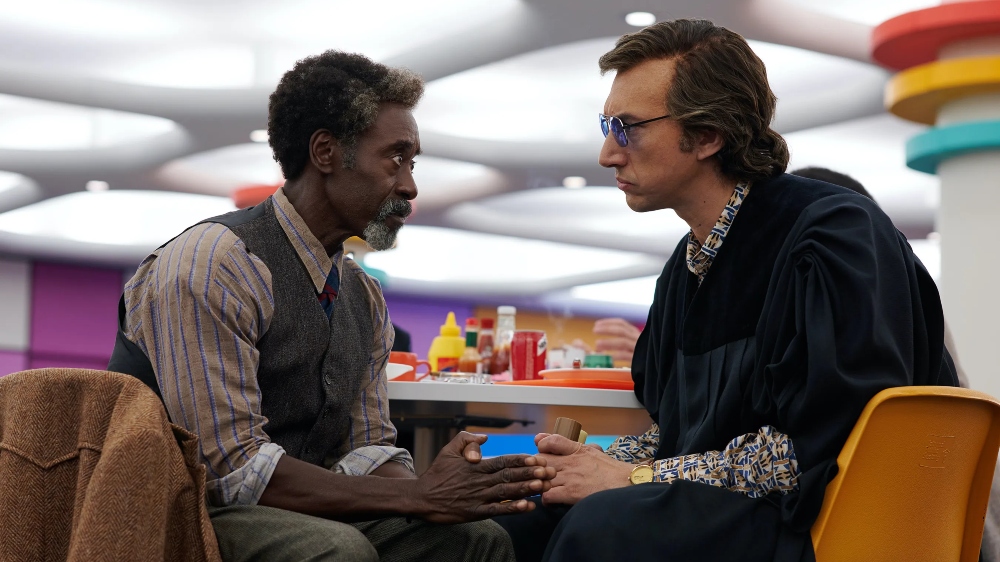
BTL: How does that play into the scenes that take place in the grocery store? Those are my favorite scenes in White Noise, and I love the way that you capture two sides, and both aisles as the actors walk down them. You’re capturing a lot in each frame, but how do you do that in a smaller space?
Crawley: The whole idea of the store was that it was supposed to be what one would call a sort of temple to consumption. Obviously, supermarkets existed pre-’80s, but I think they were a version, and are still a version, of just an absolute kind of [temple to consumption] — especially if you go into U.S. supermarkets.
I was talking about this with my dad the other day because they’re very different; there’s so much more choice in U.S. supermarkets than there is in UK supermarkets. So it’s absolutely this sort of temple to consumption. And what’s wonderful [about] Jess Gonchor‘s fantastic set design [is that] you get a real sense of all these different products. But what we wanted to do was shoot on a wide-angle anamorphic lens. So, essentially, what you are doing is as you travel up and down these aisles, it sort of accentuates speed, in a sense, or sort of sucks in the contents of each aisle into the frame, you know?
And we are gliding around it on either a version of Steadicam or most of the time it was sort of dolly moves. At the end, there’s a big sort of dance sequence over the closing credits, and we did that with Steadicam because it was faster and we needed more maneuverability than faster maneuverability of the camera.
To answer your question, [with] the wide-angle, widescreen [format], we felt it just fit very well with being able to see all of these products at once and just the way [the characters] sort of appeared and disappeared through the frame, and this sort of accentuated vanishing point of the aisles was our choice.
That was why we chose wide-angle lenses and that wide-screen format, essentially. And then there’s one particular moment on the second visit to the supermarket [where] the camera rises up and we sort of reference [Andreas] Gursky. You could check it out and if you [search his name and] “superstore,” you’ll see a kind of reference photo he took. Again, he was exploring these ideas of patterns and consumption, and so that was kind of a reference for that in the store.
BTL: A grocery store is kind of a limited space, right? But one that’s not is the river that you shot in when the car is sinking, and I feel like there’s a shot from the backseat at one point. How did you pull off that sequence?
Crawley: Wow, so that whole sequence and all of the driving stuff that precedes it — where they’re driving from the Boy Scout camp, all of the evacuation — was tricky. Just to come back to the preceding scene where [we’re] follow[ing] a vehicle, a Land Rover, away from the Boy Scout camp, and then they sort of chase through the woods, a lot of that was me operating a handheld camera in the backseat. So a lot of the shots where we were on Adam [Driver] or on Greta [Gerwig], that was me. And then we would take, say, Greta out — Adam was actually driving that sequence, so I couldn’t take Adam out — and then I was in the passenger seat at certain points. So we tried to do as much as we could handheld, just so it didn’t feel too static and it had some life to it. And then other times, we would literally just mount cameras [on] the side of the vehicle, you know?
And then other times, we had a pod; essentially, we had about five of these station wagons, and [on] one of them we cut the roof out and then had a camera mounted inside for the 360° [shot] earlier on. Another time, we had a pod, which was essentially [when] somebody sat on top of the car driving it, so you’re actually using the vehicle, but someone on the roof is controlling it and driving it remotely. I dunno if you ever saw the movie Children of Men, [but] there’s a sequence in that with a camera revolving inside the car and it was basically a similar system to how we did it.
But when we got into the creek — I mean, there are so many technical things to tell you about this film — but when we got to the creek, the special effects team constructed a car that was partially submerged in the water, and then it was able to travel up and down, and then again, we had handheld cameras [on] either side of the car, or inside the car, or we would mount cameras actually to the car.
And then we had second unit photography doing all sorts of shots outside the car and things like that. So it was a whole combination of different approaches, really. But I mean, where possible, like the shots of Adam and Greta, they were handheld, but they were just outside of the car. So, for example, the shot onto Adam would be shot [by] just poking through the driver’s side rear window, if you see what I mean. And then other times, we would be inside the car getting closer coverage.
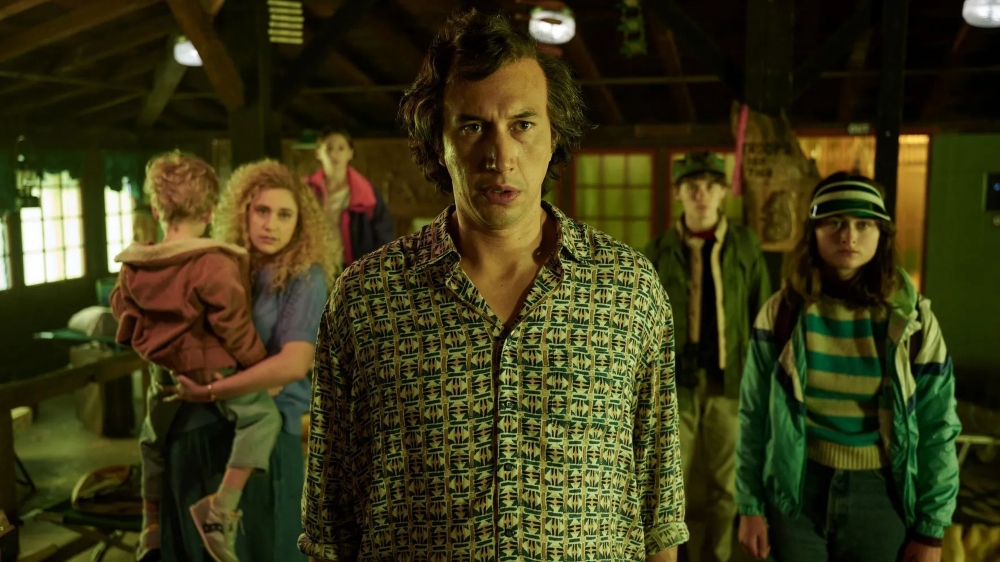
BTL: That’s really fascinating because I didn’t realize how many layers there were to this scene.
Crawley: Like a huge number, yeah. I think from my point of view, it is also important to just try and keep as much life as possible in those shots so the camera doesn’t feel too static. I’m trying to still keep some energy, but then equally, when they [begin] floating in the creek, I think there’s more of an argument [that] you could have a static camera as opposed to the wild camera that’s gone before it, you know?
BTL: Towards the end of the film, there’s a bit of a visual and tonal shift — it gets a little darker. I know you mentioned some of the reference points from earlier in the film in the grocery store, but were there any films that you looked at for the third act of White Noise? I’m especially thinking of the motel with the darkness and the rain.
Crawley: The motel, for me, is a really special sequence. I’m very proud of the whole film, but in some ways, [I’m] especially proud of the coverage and the way that manifests itself and then develops into the church. I really love the way that we sort of shot Mink (Lars Eidinger) with close, sort of distorted lenses.
I mean, really talking to Noah, we had this real sort of idea for a noir aesthetic and noir ending for the movie, you know? And then we had references like Robby Müller, the cinematographer, [and] his films in the ’80s like Paris, Texas, for example — it had very strong reds and greens contrasting with each other. We wanted these very rich colors and this sort of heightened television light and the red light outside the motel room and things. That’s really the aesthetic we were sort of leaning into for those moments. And we wanted the TV to be a very strong presence.
Also, my photography in the past has been very naturalistic. In this film, because it was kind of an ode, a slight debt to films of the ’80s of, like, Adrian Lyne and Michael Mann, there was more of a kind of “’80s Hollywood moonlight” thing going on than I would normally have. So that was fun to explore.
And then in the church, it’s pretty wild, you know, the colors and the popping colors and the lilacs and the lavenders of the nuns and things like that. There was a lot of fun to be had with that. But yeah, the motel room was a great one. And like I said, I think trying to reveal Mink slowly, and these moments where he is taking the pills and it’s kind of quite woozy and distorted and close-up, I really love those moments.
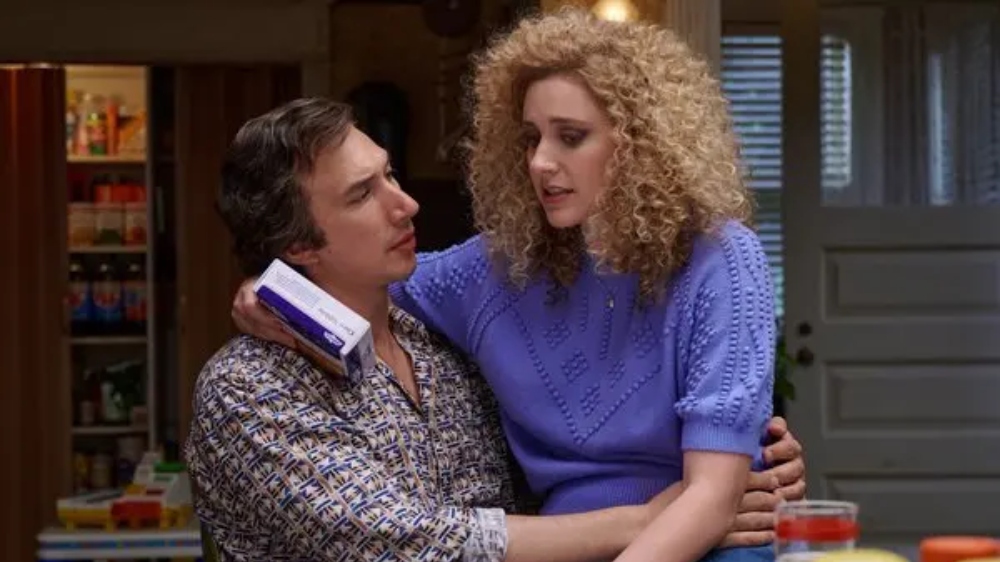
BTL: I’m glad that you mentioned Michael Mann because I thought of his work while watching White Noise, but I feared the comparison might be too easy or lazy, so I feel a bit better now that you said it.
Crawley: Yeah, I think we were sort of unapologetic about those things; or rather about those references. I mean, another obvious one is sort of the [Steven] Spielberg [of it all] in the second act of the movie, you know, like Close Encounters of the Third Kind in things like the way the camera sort of rushes up against the back of the station wagon and, obviously, when they discover the toxic cloud, and the helicopter lights and things. We were really leaning into those kinds of aesthetics of the bright overhead lights and the crane moves and the sweeping moves up — things like that.
BTL: I had read something about you and Noah having discussions about wanting to capture the “white noise of life” in the film. Could you kind of expand upon that and explain what you meant by that?
Crawley: For sure. Well, I mean, the idea of the sort of “white noise” is that for Jack Gladney’s character, I think especially, [there] is this overwhelming sense of modernity or sort of overwhelming sense of everything coming at you. And that’s what modern life kind of felt like; certainly at that time and in our contemporary society as well.
So there are certain scenes, like within the kitchen, that a lot of that is done with the audio. Throughout the film, a lot of the dialogue is sort of nonsequiturs or unanswered questions. The family [is] constantly talking over each other and the sound is mixed so that you always have this kind of sense of competing sounds and competing voices and televisions on in the background. And that’s supposed to, obviously, convey this sense of this hum of white noise through modern living.
Now, in order to sort of cut through that visually, there are a few points [where] we try to do that. There’s a shot in the Boy Scout camp where it starts as quite a wide shot at night and then it sort of hones in gradually throughout as this music plays, and then we end up on Babette (Gerwig) sitting down, and then on a pill. We see a pill in her hand, one of these white Dylar pills that she’s taking, and then it ends with her just eating the pill. And the idea for that was that visually, you have this wide shot of all this information going on and stuff going on, and then the camera just hones in and hones in and tries to cut through this white noise to this moment of the pill, which in many ways is also sort of, like, a solution for this problem. And then she consumes it.
So, yeah, I think those were some of the ideas that we were playing with in order to kind of, like, give this idea of constant information overload, if you will. The result is kind of white noise.
BTL: Lastly, do you have any projects coming up that you can talk about?
Crawley: I’m in pre-production for Brady Corbet on The Brutalist. I shot two movies for Brady — Vox Lux, and prior to that, The Childhood of a Leader. It’s gonna be on 35mm; we don’t start shooting ’til [the] new year, so you might have to wait a little while before the next one.
White Noise is now streaming on Netflix.





